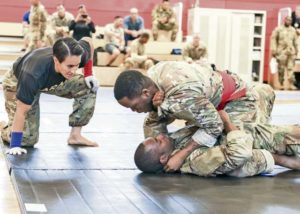
The deep thumps of the human body, the grunts of discomfort and the exhaustion of combat are all components of the Army’s Combatives Program, a hand-to-hand combat program which aims to instill the Army’s Warrior Ethos and bridge the gap between physical training and tactics.
A recent open-mat tournament tested fighting skills at Landstuhl Regional Medical Center, where over 20 U.S. military competitors from the Kaiserslautern Military Community vied for top place. The competition not only offered a chance to clash but also a venue to learn.
“It’s not just something we do for fun, it has real applications when it comes to the fighting force,” said U.S. Army Staff Sgt. Mason Idom, a platoon sergeant and certified combatives master trainer with the Medical Transient Detachment at LRMC. “It works completely different portions of your body than traditional physical training, and gives competitors a chance to showcase their skills.”
The tournament, open to military-affiliated personnel ages 18 and older, offered opportunities to practice and refine grappling skills against others, and boost camaraderie and esprit de corps between service members in an organized atmosphere.
“It’s open to everyone because we know there are some mixed martial arts programs out there and we know there are Soldiers and Airmen who may use the program as part of their physical fitness program,” said Idom. “Competitors are in a controlled environment [at the tournament]. There are instructors always watching for signs to stop the fight.”
Competitors were organized into categories based on gender and weight classes. Finishing second in her class was U.S. Army Spc. Fenny Descuatan, an operating room specialist at LRMC’s Sterile Processing Division, who previously had no combatives or martial arts experience but was prepared through MTD’s Combatives Courses weeks prior to the tournament.
“It’s only my third week involved in combatives,” said Descuatan. “It’s really good conditioning and you gain a lot of experience. In the tournament you get competitors from everywhere, not just your unit, so we get to absorb their moves and skills. I think everyone should do combatives.”
While certification in the Army Combatives Program isn’t required for all Soldiers, practicing and engaging in combatives under trained supervision is highly encouraged as part of regular physical training programs.
“Command teams are sometimes hesitant to allow Soldiers to participate because they worry the training may result in injury and put them out of the fight,” said Idom. “In reality the Army sees more injuries from football and basketball than combatives or MMA training.”
To prepare participants for the tournaments, Idom instructs them in basic and tactical combatives courses, sometimes referred to as Level I and II combatives training. Since last year, LRMC’s MTD Company has certified over 300 Soldiers and Airmen in the courses.
For U.S. Army Spc. Michael Willingham, the pre-tournament courses presented an opportunity to refresh and improve his basic combatives training. His performance and learning throughout the course encouraged Willingham to participate in the tournament where he placed second in the heavy weight class.
“I wanted to have a physical challenge, improve hand-to-hand combat skills and techniques,” said Willingham, a health care specialist at LRMC’s Internal Medicine Clinic. “Mentally, it’s one of the tougher things I’ve been through. It pushes your mind in ways you couldn’t even think of. I’m basically to the point of exhaustion every day but still have to perform.”
According to the U.S. Army Combatives School, part of the Maneuver Center of Excellence at Fort Benning, Georgia, the Army Combatives Program enhances unit combat readiness by building Soldiers’ personal courage, confidence, and resiliency as well as their situational responsiveness to close-quarters threats in the operational environment.


